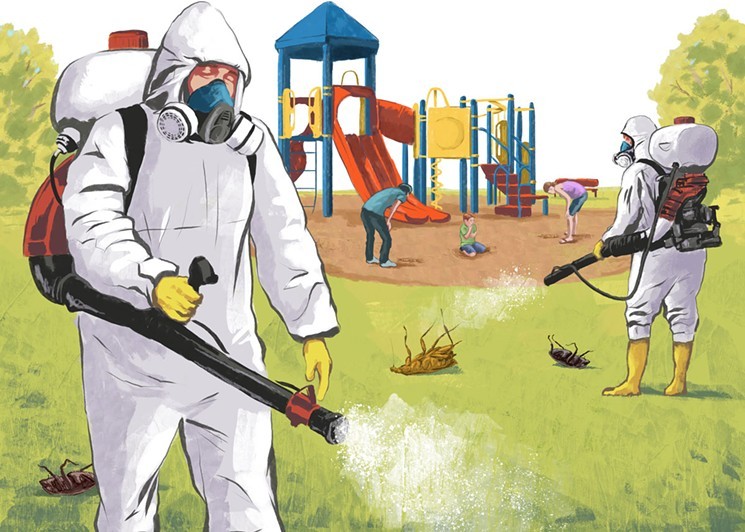 Last week, the Tustin City Council met to discuss the possibility of a synthetic pesticide-free community. After nearly half a year of meeting with councilmembers, Non Toxic Tustin—one of the many “non toxic” groups formed as a result of Non Toxic Irvine‘s success in swaying the Irvine City Council to curtail the use of toxic pesticides— finally saw their item on the agenda. But unlike Irvine, the Tustin City Council voted to do a pilot program, or test run, on two parks in the city to gauge the cost of switching to organic landscaping methods.
Last week, the Tustin City Council met to discuss the possibility of a synthetic pesticide-free community. After nearly half a year of meeting with councilmembers, Non Toxic Tustin—one of the many “non toxic” groups formed as a result of Non Toxic Irvine‘s success in swaying the Irvine City Council to curtail the use of toxic pesticides— finally saw their item on the agenda. But unlike Irvine, the Tustin City Council voted to do a pilot program, or test run, on two parks in the city to gauge the cost of switching to organic landscaping methods.
The Tustin City Hall was packed. Members of Non Toxic Irvine attended to support Non Toxic Tustin in their pursuit for a less toxic environment. Residents of Tustin and their families showed up to speak and encourage the council to make the switch to organics. Dr. Bruce Blumberg, a professor of developmental and cell biology at UC Irvine (also one of the members of Non Toxic Irvine), gave a presentation on the science of endocrine disruption—an interference of any aspect of hormone action caused by exogenous chemical or mixture of chemicals.
According to Blumberg, who cited the National Institute of Environmental Health Sciences, there are well over 50 endocrine disrupters people are regularly exposed to, including toxic herbicides like 2,4D and glyphosate—the active ingredient in Monsanto’s Round Up. Nearly 287 toxic chemicals are found in umbilical chord blood. 180 of those chemicals, he explained, are known to cause cancers in humans or animals (humans are animals), while 208 of those chemicals are developmental toxins. Pretty scary, right?
Ayn Craciun, a member of Non Toxic Irvine and former resident of Tustin, spoke to the council about the fiscal benefits of using organic landscaping methods— an issue the city of Tustin regarded as their largest hurdle. “Cost is a subject that frequently comes up in conversations about organic landscaping,” she said. “But studies show that costs are lower with organics over a five year term. In fact, Harvard University switched to organic landscaping in 2008 and on their website it says that irrigation needs were reduced by 33 percent on their organically maintained test plots. That’s partly because organic matter retains water and the roots are longer so it can better be taken up by plants…”
But when discussing fiscal matters, how do the parents of children with brain cancers said to be tied to pesticide exposure fit into the equation? Craciun also pointed out that factor to the council. “I personally know three children diagnosed with brain cancer in the last 10 years,” she said. “All the mothers lived in our neighborhood while they were pregnant and lived in a community where glyphosate was routinely sprayed on paved areas immediately next to doorsteps and A/C units during their pregnancies. I brought with me a list of 28 peer reviewed studies from well respected journals tying brain cancer to pesticide exposure. One little boy’s 6-month treatment at CHOC cost his parents $100,000. These costs are very real even if they don’t accrue directly to the landscaping company or in this case to the city.”
Residents from Tustin, including two women named Dede and Robin Ganhal, brought up the fact they don’t feel safe allowing their children to run around barefoot at the park and roll around in the grass. In other word, they don’t feel safe allowing their children to be children. They explained they don’t feel safe when their children play field sports, like soccer, because the grass is doused in toxic maintenance pesticides.
Non Toxic Irvine member Laurie Thompson shared the heartbreaking story of her daughter who was diagnosed with a severe form of brain cancer at 14 months old. Her daughter, now 7-years-old, is still suffering the repercussions of going through treatment at such a young age. “I look at [my daughter] and I see a miracle,” she said to the council. “I look at all of you and I see hope. I see hope for a better future for our children…We ask people in positions of leadership to take action to protect our children to prevent further diagnosis’ that could occur from the application of toxic pesticides.”
Of those who spoke to the council, Jim Blake was the only one in attendance not 110 percent with the cause. Mispronouncing the word glyphosate every time he used it (albeit, it’s a tough word), Blake explained that although he is open to a more organic situation, he offered studies that denounce the severe toxicity of glyphosate. “If you go look at the joint [Food and Agriculture Organization] they say that glyphosate is unlikely to pose a carcinogenic risk to humans from exposure than through diet. Diet is a higher exposure than dermal contact.”
Blake went on to state other findings, including one from the European Union, that say glyphosate does not “meet the criteria to be classified as a carcinogen, mutagen or toxic to reproduction,” arguing that Tustin would thus be wasting money if they switched to organics because the current method of landscaping maintenance is safe.
After nearly 15 people spoke, the council deliberated for 20 minutes about the financial burden of switching to organics. One councilmember said, “I am well aware of Irvine’s financial stability, and we are not Irvine.” The cost of eliminating toxic pesticides, the council concluded, would be $300,000—a cost they’d have to dip into the reserves to cover. Thus, the council decided they’d go with alternative number three: A pilot program testing the organic landscaping methods on Cedarville Park and the Tustin Sports Park. The council’s logic being that they’d get a better understanding of the budget needed to incorporate these practices into the financial plan in years to come.
Although this outcome doesn’t necessarily sound bad, Non Toxic Tustin, Non Toxic Irvine and residents from both cities found the outcome to be somewhat of a cop out. “An organic pilot is not a win for Tustin residents,” said Kim Konte, a Non Toxic Irvine member, over email.
The Non Toxic folks have their work cut out for them, as cities like Costa Mesa and Huntington Beach have also decided to do a similar program as Tustin. “We are very disappointed,” Craciun told the Weekly. “San Juan Capistrano is in a worse financial position [than Tustin] and they went for it. But at least they want to do something— the pilot program will be a success if Irvine’s experience is any indication.”



CBD exceeded my expectations in every way thanks https://www.cornbreadhemp.com/products/cbd-sleep-gummies . I’ve struggled with insomnia on years, and after trying CBD pro the prime age, I for ever trained a busty nightfall of relaxing sleep. It was like a force had been lifted misled my shoulders. The calming effects were merciful despite it sage, allowing me to roam free logically without sensibility woozy the next morning. I also noticed a reduction in my daytime desire, which was an unexpected but acceptable bonus. The partiality was a fraction lusty, but nothing intolerable. Whole, CBD has been a game-changer quest of my slumber and angst issues, and I’m appreciative to procure discovered its benefits.